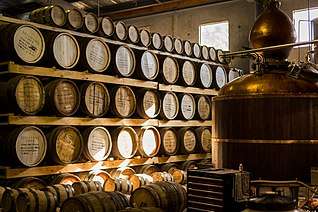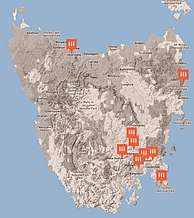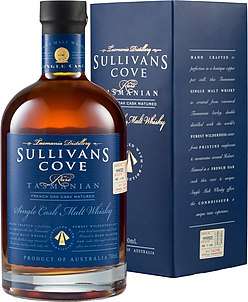Australian whisky
Australian Whisky is whisky produced in Australia. As of March 2020, there were 293 registered distilleries in operation within Australia, of which approximately 50 have a whisky on the market.[1] The Industry has shown steady growth since the early 90s especially in the boutique craft distilling scene.[2]

Most Australian whisky is produced using a very similar process to that of Scottish whisky, however the flavour of Australian whisky is subtly different.[3] Although the majority of whisky produced in Australia is in the Single Malt style there is more variation than what is found overseas, with no strict customs or traditions governing the styles produced. Multiple styles of whisky are produced in Australia, including single malt, rye, wheat and blended whiskies.[2]
Australian whisky was popularised globally in 2014, when Sullivan’s Cove French Oak single cask won the world’s best single malt whisky at the World Whiskies Awards.[4][5] This was the first time a distillery outside of Scotland or Japan had won this category.[6]
History
Whilst Australia has a long history of whisky distilling, dating back to 1820, the whisky industry looks very different in the 21st century to when it begun. Distillation was legalised by the Australian government at the end of 1820, and by 1822 the first legal distillery was opened in Tasmania.[3][7]
Prior to 1990, over 85% of whisky production came out of Victoria. While Tasmania had a small whisky industry in the early 1820s this ended quickly and there was no whisky produced in Tasmania between 1838 and 1990. Sydney also had two large distilleries in operation between 1825, and 1850 when their focus shifted to making rum instead.[2][3]
It is estimated that a total of 140 million litres of whisky was produced in Australia between 1822, and 1979, however, no whisky was produced in Australia between 1980 and 1990. The Whisky industry in Australia can be broken down into three distinct periods: The colonial malt whisky period (1863–1929), The blended whisky period (1930–1980) and finally the boutique whisky period, since 1992.[2][3]
The colonial malt whisky period (Victoria 1863–1929)
Following the Victorian Distillation Act of 1862, the first large scale whisky distillation in the country began in 1863, with the opening of John Dunn’s Warrenheip distillery outside Ballarat; Warrenheip distillery was Australia’s second largest distillery until 1930.[3][2]
In 1888 the Federal distillery was constructed in Port Melbourne and was the third largest distillery in the world at the time. By 1894, Federal Distillery produced in excess of 1.1million litres of spirit per year, however not all of this was whisky, as the distillery also produced brandy and gin.[3]
Blended whisky period (Victoria 1930–1980)
The second major period in Australian whisky history began when large British distilling companies started opening distilleries within Australia, using imported materials from Britain. In 1930, the Distillers Company of Edinburgh (now known as Diageo), opened Corio distillery outside Geelong; Corio Distillery replaced Warrenheip as the largest producer of whisky in Australia. Soon after opening, Corio Distillery merged with Federal Distilleries company.[3]
Following the end of World war II, Gilbey’s of London, the second largest distiller in the world at the time, opened a distillery in Melbourne, simultaneously acquiring the Milne Distillery in Adelaide.[3]
This meant that almost all whisky distillation in Australia was controlled by the two international distilling companies Gilbey’s of London, and the Distillers Company of Edinburgh. At the time protectionist laws gave both companies a 40% price advantage over imported Scotch whisky. Based on this, both companies made the commercial decision to produce lower quality whisky in Australia, in order to control the cheap whisky market within the country.[3] This resulted in a poor quality and reputation for the whisky produced in Australia during that period.[2][7]
In 1960, the protectionist tariffs on imported whisky were removed, meaning that imported whisky was much more affordable. This led to a significant drop in demand for the lower quality whisky being produced in Australia domestically as the price of the superior imported whisky dropped. As a result of this by 1980, both major Australian whisky distilleries had shut down and been sold.[3]
The boutique whisky period (Since 1992)
In the early 1990s several small craft distilleries began to open beginning with Lark distillery in 1992, and followed by other small distilleries in Tasmania and Victoria.[3] Prior to 1990, distillation in Australia was only accessible to large commercial companies, this was due to the Distillation Act of 1901, which prevented licenses from being issued for distilleries whose primary wash still was smaller than 2700 litres. By comparison, in 2020 one of the largest independent distilleries in Australia, only used an 1800 litre Wash still. In 1990 Bill lark, who is the founder of Lark whisky, lobbied the government to have this restriction amended, and he is largely credited as being responsible for overturning this law.[2]
Since 1990, the Whisky industry in Australia has seen significant growth, as of 2020 there are over 293 Distilleries in operation within Australia, of which an estimated 50 have whisky products on the market, with more in the process of creating their first whisky.[1]
Modern distilleries by state
As of 2020, there were approximately 50 active distilleries producing whisky in Australia. Whilst Tasmania hosts the largest concentration of whisky distilleries in Australia, there are also many whisky distilleries scattered throughout Australia.[1][8]
Tasmania
Tasmania has the most distilleries of any state in Australia by far, with over 22 whisky distilleries in 2020.[1] This is due to conditions in Tasmania being very suitable for whisky production. The climate has a large diurnal temperature range, and seasonal variation, which is desirable for whisky maturation.[8][9] In addition, distilleries in Tasmania claim to use some of the best quality water in the world.[10][11]

Notable Distilleries:
- Lark distillery: Often referred to as the grandfather of craft whisky in Australia, Bill lark begun distilling in 1992 at home, and shortly after opened the first whisky distillery in Tasmania since the 1830s.[3][12] In 2015, Bill Lark was inducted into the Whisky Hall of fame, and at the time was only the seventh person outside Scotland or Ireland to be given the honour.[12]
- Sullivans cove distillery: The second-longest running modern whisky distillery in Australia, Sullivan’s Cove was established in 1994, however changed ownership in 1999.[13] Under the new owners Sullivan’s Cove has won many awards for their whisky, most notably the world’s best single malt in 2014.[4][5][6]
- Hellyers road distillery: Founded in 1999 by a boutique milk co-operative ‘Betta Milk’, Hellyers road distillery exports to over 20 countries in 2020.[14]
New South Wales
After Tasmania, NSW has the second most whisky distilleries in Australia, with 9 whisky distilleries in 2020, and has a large number of urban distilleries located in the Sydney area.[1]
Notable Distilleries:
- Archie Rose Distillery: Founded in 2014, Archie rose was the first new distillery to open in Sydney since 1853, and initially were known for their gin and vodka.[15][16] In 2018, Archie rose began releasing rye malt whisky, and was awarded the world's best rye whisky in 2020.[4]
- Manly Spirits: Founded in 2017, manly spirits primarily produces gin and vodka, however begun production of whisky to be released in 2020.[1]
Victoria
Victoria has 7 active whisky distilleries, much like Sydney many of these are located in the city of Melbourne.[7][17]

Notable Distilleries:
- Starward: Established in 2004, Starward was founded under the name New World Whisky distillery in an old Qantas Airlines hangar.[18] Starward distillery is known for its wine cask whisky, matured exclusively in wine barrels sourced from the Barossa valley region.[2]
- Bakery Hill Distillery: Founded in 1999 by biochemist David Baker, Bakery hill distillery is one of the few Australian whiskies that is made in the peated style. The distillery has received many international awards for its whisky.[19][18]
Western Australia
There are four whisky distilleries in Western Australia as of 2020. Though a small fledgling industry, Western Australia whiskies have won international awards, in particular Limeburners whisky distillery won best international whisky in 2017.[1][20]
South Australia
Many of the distilleries in South Australia are near or within wine growing regions and take advantage of the tourism and wine barrels this provides. Many of the distilleries producing whisky in South Australia started out producing craft gin, and many begun producing whisky in 2019 and 2020.[1][20]
Critical reception and awards

Until early 1990’s, Australian whisky poorly regarded both internationally and within Australia, with mass-produced low quality whisky dominating the market. Whisky produced during the mid-1900s had a poor reuptation locally, and was considered inferior to imported products.[3][8] After the emergence of the craft whisky scene in the 1990s, Australian whisky began garnering attention from international critics.[4][5]
In 2013, prolific whisky critic Bill Murray praised the fledgling Australian whisky industry, describing a Sullivans Cove whisky as “a staggering achievement”.[10] This international attention culminated in 2014, when Sullivans Cove distillery won the world's best single malt at the world whiskies awards for its Single Cask French Oak whisky.[2] The award was of particular importance as it marked the first time a distillery outside of Scotland or Japan had won, and helped garner worldwide attention for the relatively small Australian whisky industry, and was an excellent source of international promotion.[2][4][5]
Australian whiskies continued performing well internationally with multiple distilleries placing highly in worldwide competitions, notably Sullivans Cove continued to be awarded the world's best single cask single malt whisky in 2018 and 2019.[22]
In addition to the single malts, in 2020 Archie rose distillery was awarded the world’s best rye whisky, a category formerly dominated by the USA and Canada.[22]
Style and process
Like all whisky, grain is the principle ingredient in Australian whisky production, being required for its sugar content (see distillation). Traditionally in Scotland malted barley is used to distil ‘malt whisky’ whereas ‘grain whisky’ is produced from the cheaper grains such as corn, oats or wheat, and can be produced at a higher volume. Blended whiskies are the created through the process of blending the more neutral grain whisky with the much more flavourful, albeit more expensive malt whisky. Distillation processes for distilling whisky vary across the world; Australia uses the same double pot still method to that widely used to distil single malt whisky in Scotland.[3][19]
Whilst Australian whisky is produced using a very similar method to Scottish whisky, the resulting flavour is slightly different. Unlike the Scotch industry Australia has no deep customs or traditions surrounding its whisky, resulting in an increased variation in styles and flavours of whisky produced within Australia.[19][2]
Whilst the USA stipulates whisky be made using only new unused American oak barrels, Australia (and Scotland) does not have this constraint. Due to this most Australian whisky is matured in ex-bourbon barrels, with most of the remainder matured in ex-port barrels.[3]
There are also many distilleries which take advantage of the well-established Australian wine industry, for example, Starward distilleries’ wine cask edition whisky exclusively uses ex-wine casks from the Barossa wine producing region.[2]
Many of the whiskies produced in Australia use brewing barley, instead of traditional distilling barley; brewing barley has a slightly different and stronger flavour than distilling barley, this lends a unique flavour to many Australian whiskies.[10][19]
Economic impacts
Since the late 2000s, many rural areas of Australia have seen growth in tourism related to the whisky industry, and many regions promote Australian whisky trails.[10][23]
As worldwide awareness of Australian whisky grows, many producers are beginning to export larger quantities overseas.[10] As of 2020, the whisky industry in Australia remains relatively small, and Australians consume only an estimated 1% of locally made spirits. Many small distilleries cite the excise tax regime in Australia as an obstacle to growth, with a standard 700ml bottle attracting close to $30AUD in tax depending on alcohol concentration.[2]
Further reading
- Lloyd, Bernard (2017). Tasmanian Whisky: The Devil's Share. South Hobart: Tas Food Books. ISBN 9780646916552.
External links
| Wikimedia Commons has media related to Whisky from Australia. |
- Liquor lovers whet their whistles in Perth's spirit renaissance – ABC 7.30 segment about whisky production and consumption in WA
References
- "Australian Distilleries". The Whisky List. Retrieved 22 April 2020.
- "The rise of the craft Australian distilleries - Part 1". www.diffordsguide.com. Retrieved 23 April 2020.
- Middleton, Chris (2011). "Australian Whisky: Whisky Phoenix Rises - a Short History of Australian Whisky Distillation". Chemistry in Australia. 78: 18–22.
- Frost, Vicky (2 April 2014). "Tasmania's latest export: the best whisky in the world". The Guardian. ISSN 0261-3077. Retrieved 28 May 2020.
- Colquhoun, Steve (21 March 2014). "Tassie whisky named world's best single malt". The Sydney Morning Herald. Retrieved 28 May 2020.
- McLaughlin, Martyn; Smith, Claire (30 March 2014). "Best whisky in the world award goes to ... Tasmania". The Scotsman. Retrieved 20 April 2020.
- Atkinson, James. "On the expediency and necessity of encouraging distilling and brewing from grain in New South Wales". nla.gov.au. Retrieved 28 May 2020.
- "Tasmania Makes Some of the World's Best Whisky". Broadsheet. Retrieved 28 May 2020.
- "Tasmanian Whisky". www.diffordsguide.com. Retrieved 28 May 2020.
- Courtney, Pip (6 July 2013). "Tasmanian whisky given high praise by critic". ABC News. Retrieved 23 April 2020.
- Morgans, Julian (20 May 2014). "An Island You've Never Heard of Is Making the Best Whiskey You've Never Tasted". Vice. Retrieved 28 May 2020.
- "Bill Lark – 2015". Whisky Magazine. 11 November 2015. Retrieved 20 April 2020.
- Alomes, Jon. "Sullivans Cove Distillery". Discover Tasmania. Retrieved 28 May 2020.
- "The Tasmanian Whisky Trail". The Tasmanian Whisky Trail. Retrieved 28 May 2020.
- "Sydney's Best Distilleries Where You Can Sip Spirits Straight from the Still (or Barrel)". Concrete Playground. Retrieved 28 May 2020.
- "Archie Rose Distillery, Sydney". The Gin Queen. 15 March 2015. Retrieved 28 May 2020.
- Victoria, c=au; o=Visit. "Distilleries, Food and wine, Victoria, Australia". Visit Victoria home. Retrieved 29 May 2020.
- "Our Top Three Victorian Whisky Distillers » Drinks Catering Melbourne Bar Hire". www.drinkscatering.com.au. Retrieved 28 May 2020.
- Broom, David (2014). The World Atlas of Whisky. London: Octopus Books. ISBN 9781845339425.
- "WA drop named 'best whisky in the world'". The West Australian. 6 April 2017. Retrieved 28 May 2020.
- "High Spirits: Queensland's artisan spirit makers". Brisbane Airport. Retrieved 28 May 2020.
- "Australia strides the stage at prestigious world whisky awards". Executive Traveller. Retrieved 28 April 2020.
- "The Australian Whisky Trail". The Sydney Morning Herald. 13 July 2012. Retrieved 28 May 2020.